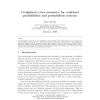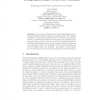227 search results - page 16 / 46 » P Systems and Finite Automata |
JAC
2008
13 years 11 months ago
2008
Cellular automata are a simple model of parallel computation. Many people wonder about the computing power of such a model. Following an idea of S. Wolfram [16], M. Cook [3] has pr...
ENTCS
2008
13 years 10 months ago
2008
Non-deterministic (also known as possibilistic) and probabilistic state based systems (or automata) have been studied for quite some time. Separately, they are reasonably well-und...
QEST
2008
IEEE
14 years 4 months ago
2008
IEEE
We begin by observing that (discrete-time) QuasiBirth-Death Processes (QBDs) are equivalent, in a precise sense, to (discrete-time) probabilistic 1-Counter Automata (p1CAs), and b...
PTS
2007
13 years 11 months ago
2007
Abstract. We propose an extension of the Finite State Machine framework in distributed systems, using input/output partial order automata (IOPOA). In this model, transitions can be...
TSMC
2002
13 years 9 months ago
2002
Automata models of learning systems introduced in the 1960s were popularized as learning automata (LA) in a survey paper in 1974 [1]. Since then, there have been many fundamental a...


